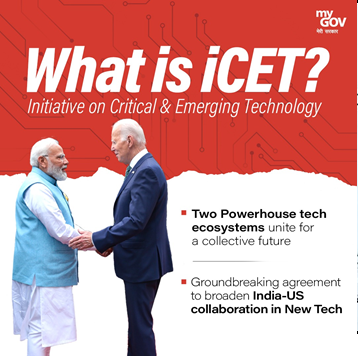THE INNATE LIMITATIONS IN EXECUTING ICET
Relevance:
- GS 2 – Important International institutions, agencies and fora-their structure, mandate
- GS 3 – Awareness in the fields of IT, Space, Computers, robotics, nano-technology, biotechnology and issues relating to intellectual property rights.
Why in the News?
- Despite seemingly successful talks in June between National Security Adviser Ajit Doval and his U.S. counterpart Jake Sullivan, aimed at advancing the bilateral Initiative on Critical and Emerging Technologies (iCET), structural challenges persist in its implementation.
- Impediments mainly relate to the autonomy of U.S. Defense companies in technology transfers.
Impediments to Technology Transfer
- Autonomy of U.S. Defense Companies:
- Local industry officials and military analysts indicate that impediments are primarily related to the autonomy of U.S. defense companies in technology transfers.
- These technologies, developed at significant cost at Washington’s behest, are zealously guarded by companies protecting their intellectual property rights (IPR).
- S. Export Control Laws:
- The S. maintains strict export control laws, managed by its defense industrial complex, which are reluctant to share military technologies through joint ventures, regardless of their potential strategic importance to Washington.
Current Focus of iCET’s Defense Component
- Local Manufacturing:
- The iCET’s defense component currently focuses on the local manufacturing of General Electric GE F-414INS6 afterburning turbofan engines for the under-development Tejas Mk-II light combat aircraft.
- Local Assembly of UAVs:
- Additionally, the local assembly of 31 armed MQ-9 Reaper/Predator-B unmanned aerial vehicles (UAVs) is planned, intended for use by all three services, with an acquisition cost of around $3 billion.
Background of DTTI to iCET
- The Defense Technology and Trade Initiative (DTTI) failed due to technology transfer issues, leading to the emergence of the iCET in June 2023 with a more ambitious remit.
- The iCET is supported by various organizations, including INDUS-X (India-U.S. Defense Acceleration Ecosystem), Joint IMPACT (INDUS-X Mutual Promotion Advanced Collaborative Technologies) 0, IMPACT 2.0, and ADDD (Advanced Domains Defense Dialogue).
Limitations to Technology Transfer
- Technology Transfer Constraints:
- Official sources claim negotiations were concluded for GE to transfer around 80% of the technology to Hindustan Aeronautics Limited to produce the F-414 engines.
- However, critical know-how related to forging metallurgy discs for the power pack turbines is not included.
- Technology transfer from General Atomics Aeronautical Systems to assemble the MQ-9s reportedly stands at around 10-15%, including the establishment of a domestic maintenance, repair, and overhaul (MRO) facility for the UAVs.
- Ongoing Negotiations:
- Negotiations are also underway for the direct acquisition, license-building, and co-development of the General Dynamics Land Systems Stryker Infantry Combat Vehicle for the Indian Army under iCET patronage.
- Innate Limitations:
- Military analyst Abhijit Singh noted that theS. government does not presume to act on behalf of its defense companies that own the IPRs for their various products.
- S. defense vendors are answerable to their shareholders, whose motivations are largely commercially driven, potentially limiting the amount of technology they are willing to transfer.
- These commercial considerations, coupled with cumbersome bureaucracies, contributed to the failure of the 2012 Defense Technology and Trade Initiative (DTTI) between India and the U.S.
Leveraging ‘Jugaad’ for iCET Success
Over decades, India’s armed forces have refined jugaad to enhance foreign weapon systems, such as elevating Chetak and Cheetah helicopters (originally French Alouette III’s and SA-315B Lama’s) to operate at heights exceeding 14,000 feet in the Siachen glacier region.
- Strategic Approach: Domestic defense industry officials propose leveraging ‘jugaad’—India’s innovative approach—to ensure success in iCET and related projects.
- This involves permitting the Indian military to apply jugaad to U.S. platforms like attack and heavy-lift helicopters, heavy transport aircraft, and naval surveillance aircraft already acquired.
- Jugaad has historically provided flexibility, enabling imported platforms to function effectively in diverse climates and terrains, often surpassing original performance expectations.
- Challenges to Jugaad: Despite the proven benefits, complex protocols established between India and the U.S. before acquiring these assets restrict the application of jugaad.
- Acquisitions through the Foreign Military Sales (FMS) route, under the ‘Golden Sentry’ end-use monitoring program, explicitly prohibit jugaad practices.
- Policy Alignment:
- The iCET aligns with U.S. policy objectives, as highlighted in a recent Senate Foreign Relations Committee report urging President Biden to address India’s strategic ties with Moscow and reduce dependency on Russian arms.
- The report suggests India should increasingly procure military equipment from the U.S., potentially through avenues like iCET.
- Caution Against Laws:
- There is a caution against the iCET falling prey to Augustine’s Laws, which humorously caution against excessive discussion without corresponding action.
- Ensuring iCET’s operational success will require a balance between strategic dialogue and effective implementation to avoid the pitfalls of bureaucratic inertia.
- The iCET aligns with U.S. policy objectives, as highlighted in a recent Senate Foreign Relations Committee report urging President Biden to address India’s strategic ties with Moscow and reduce dependency on Russian arms.
Way Forward
- Enhance Collaboration: Foster deeper collaboration between Indian and U.S. defense sectors under iCET, focusing on mutual technology transfers and joint ventures.
- Adapt Jugaad Approach: Explore avenues to integrate India’s jugaad innovation into existing and future U.S. military platforms, ensuring operational flexibility and efficiency.
- Navigate Regulatory Challenges: Address complex regulatory protocols hindering jugaad practices, particularly under the FMS route, through strategic negotiations and agreements.
- Strategic Alignment: Ensure iCET aligns with broader U.S. strategic goals, including reducing India’s reliance on Russian arms, while enhancing bilateral defense ties.
- Action-oriented Implementation: Prioritize actionable outcomes over prolonged discussions, leveraging iCET’s framework to expedite technology integration and defense cooperation.
- Monitor and Adapt: Continuously monitor iCET initiatives to mitigate risks of bureaucratic inertia, ensuring timely adjustments and enhancements based on operational feedback.
Associate articles
https://universalinstitutions.com/india-us-relationship/
https://universalinstitutions.com/from-warp-speed-to-reset-the-state-of-india-u-s-ties/
Source: https://www.thehindu.com/opinion/op-ed/the-innate-limitations-in-executing-icet/article68386091.ece
Mains question
Discuss the strategic implications of India’s ‘jugaad’ approach in enhancing defense capabilities through initiatives like iCET. How can these innovations overcome challenges in technology transfer and bilateral defense partnerships? Explain.




